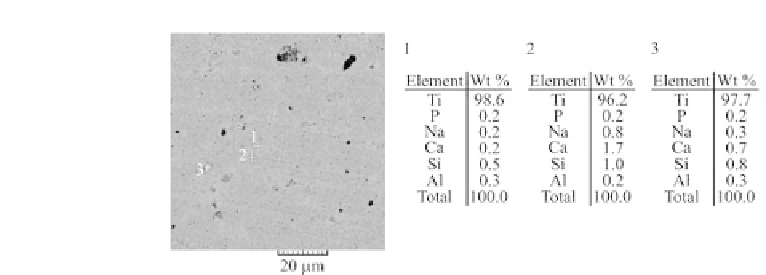Biomedical Engineering Reference
In-Depth Information
Figure 7.11
EDS spectra of surface of Ti-10 vol% 45S5 Bioglass mech-
anically alloyed for 20 h and heat treated at 1150˚C for
2 h [24].
As shown in Table 7.4 the Vickers microhardness of Ti-3 wt%
45S5 Bioglass and Ti-10 wt% 45S5 Bioglass nanocomposites are
500 HV and 620 HV, respectively and are higher than that of pure
microcrystalline titanium. The addition of silica to titanium has a
positive effect on the corrosion resistance of titanium. The corrosion
resistance increases with the rise of ceramic contents. The Ti-10 wt%
45S5 Bioglass nanocomposite possesses higher corrosion resistance
and thus higher corrosion current densities than microcrystalline
titanium.
7.5 Ti-Al
2
O
3
Nanocomposites
Alumina ceramics have good biocompatibility and good mechanical
properties (particularly the parameters of friction and wear). It is
biologically inert, which means that it practically does not emit any
components to the biological environment. Due to it high resistance
to wear by friction, this can signiicantly improve poor tribological
properties of titanium.
Amorphous material is form after 20 h of mechanical alloying
process [24]. The formation of the bulk nanocomposites was achieved
by annealing of the amorphous materials. XRD and EDS analysis of
Ti-10 vol% Al
2
O
3
showed the presence of α-Ti type structure with
nanograins of aluminum or aluminum oxide (Fig. 7.12). The average
crystallite size of heat treated Ti-Al
2
O
3
nanocomposites is about
35 nm.















